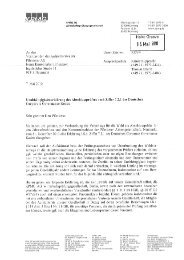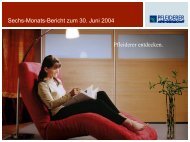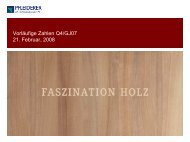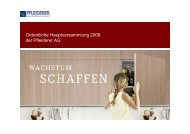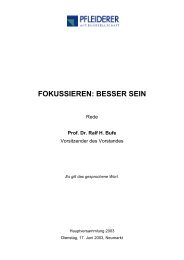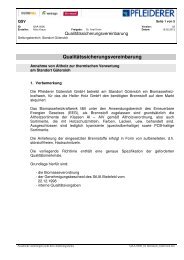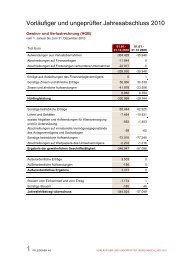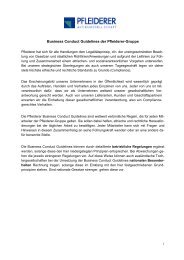PDF, 1.2 MB - Pfleiderer AG
PDF, 1.2 MB - Pfleiderer AG
PDF, 1.2 MB - Pfleiderer AG
You also want an ePaper? Increase the reach of your titles
YUMPU automatically turns print PDFs into web optimized ePapers that Google loves.
3. Long-term investments<br />
and securities classified as<br />
current assets<br />
4. Derivative financial<br />
instruments<br />
5. Costs of capital procurement<br />
6. Stock options<br />
7. Currency translation<br />
consolidated financial statements notes pfleiderer ag 115<br />
HGB requires that securities be carried at the lower of amortized cost or fair value as of the<br />
balance sheet date. Under US GAAP, SFAS 115 rules that securities are valued by category.<br />
Securities available for sale, i.e. securities not held for trading purposes or until maturity,<br />
are marked to market at balance sheet date. Unrealized profits or losses are directly transferred<br />
to equity. Where unrealized losses are other than temporary, the security is amortized.<br />
The write-down cannot be reversed later through write-ups affecting net income.<br />
HGB has no binding procedures for accounting and valuing derivative financial instruments,<br />
with the effect that valuation takes account of the historical cost, realization and imparity<br />
principles.<br />
US GAAP, on the other hand, requires that all original and derivative financial instruments<br />
be measured at fair value. Under certain restrictive conditions, US GAAP requires that hedging<br />
be recognized on the balance sheet, which means that fluctuations in financial instruments<br />
used for hedging purposes are not directly shown as expenses or income, but must be temporarily<br />
recognized under equity. The criteria for recognition on the balance sheet include the<br />
underlying transaction secured and the type of financial instrument involved. Where the conditions<br />
for recognition are not fulfilled, fluctuations are shown as income or expenses in the<br />
income statement during the period in which they occur.<br />
Under German law, costs of capital procurement must be accounted as expenses and may not<br />
be offset against cash inflow arising from capital increases. Under US GAAP, costs of procuring<br />
equity, for example the issuing costs incurred for an IPO less the effect of their tax deductibility,<br />
may be deducted from the gross amount of capital procured, thus reducing additional paidin<br />
capital.<br />
There is no principal legal opinion in Germany as to how stock options granted to employees<br />
should be accounted. Under US GAAP, stock options are mainly dealt with by APB 25 and<br />
SFAS 123. Under APB 25, stock options are treated according to their intrinsic value, whereas<br />
in SFAS 123 they are recognized at fair value. The Company has decided to apply APB 25 for<br />
its stock options, the intrinsic value being the difference between the exercise price and the<br />
higher market share price at balance sheet date.<br />
Under HGB rules, foreign currency receivables and payables not covered by forward currency<br />
hedging are carried at the exchange rate on the date of transaction or the balance sheet date,<br />
whichever is more unfavorable. Under US GAAP rules, SFAS 52 requires that all foreign currency<br />
receivables and payables be translated at the exchange rate prevailing at balance sheet<br />
date, with the potential result that unrealized profits from exchange rates can affect profits<br />
and losses.





